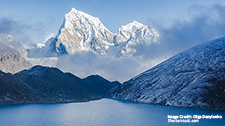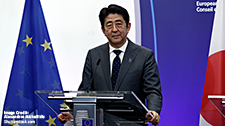The Climate Crisis in Tibet: The Dalai Lama’s Warning

Jagannath Panda and Ana Carolina De Oliveira Assis
Earlier this year, at the ninth International Conference of Tibet Support Groups (TSGs) – a political advocacy meeting for raising awareness about Tibetan issues – held in Brussels, with over 170 delegates from 40 countries around the world, the Dalai Lama in his message highlighted Tibet’s environmental concerns as a global problem. This is not the first time the revered Tibetan leader has tackled climate change, particularly the effects of ecological degradation due to wanton human activities.
Over the years, be it his speech at the “Endangered Tibet” conference in 1996 or his remarks at the 2021 United Nations Climate Change Conference (COP26) to name just a couple, the Dalai Lama has not only cautioned about the global ramifications of “ecological neglect” in the Third Pole but also emphasized the vitality of the “spirit of solidarity and cooperation” to counter such transnational challenges.
But if the world at large has thus far remained relatively unmindful of heeding the Buddhist leader’s words, what is the relevance of the Dalai Lama’s climate advocacy today? First, there is the direct correlation of his teachings on the interdependence of species on each other and on nature, and the impact of human-driven environmental changes, including severe water shortage.
Second, the significance of the Dalai Lama’s efforts in advocating for climate action is related to the geopolitical aspect of China’s repression of Tibetan people and culture, as well as accelerating Tibet’s climate crisis through myriad infrastructure developments (from mega-dams to over-mining). In this context, the Dalai Lama has also not shied away from calling out China for not just “neglecting” the ecological devastation in the Tibetan Plateau, but actively participating in the overexploitation of natural resources, such as through mining and damming, “without proper environmental safeguards.”
The third reason is the current extremely divided political landscape where the democratic states, and not just in the West, are increasingly recognizing the imperative to counter China’s militaristic aims, including in Tibet. China’s financial and diplomatic support of several authoritarian regimes like Russia, North Korea, and Iran have also created greater concerns about the dangers to the liberal order. Thus, today, there is potential for greater receptivity more than ever.
Against this scenario, what is the extent of Chinese activities on the Tibetan and Himalayan ecology? What specific measures must the West and India take to address the ecological balance in the Himalayas?
Assessing the Climate Crisis in the Third Pole
The Tibetan Plateau and its surrounding mountainous areas are commonly considered the “Third Pole” because they are home to the largest reservoir of glaciers and ice sheets on earth after the Arctic and Antarctica polar regions. In effect, several major rivers such as the Mekong, Salween, Yellow River, Yangtze, the Yarlung Tsampo (the Brahmaputra in India), the Indus (or Sengge Chu, the Lion River, in Tibetan), Irrawaddy (likely from the Sanskrit term airāvatī, the Elephant River), Ganges, Sutlej, and the Karnali (called Mabja Tsangpo, the Peacock River, in Tibet and Ghaghra in India) rise in the Plateau. Thus, it serves as the “Water Tower of Asia,” providing fresh water and vital sources of livelihood to billions of people not just in Tibet but across countries in South and Southeast Asia.
Moreover, the Plateau is not only one of the most biodiverse regions in the world but also rich in minerals, including rare earth reserves. Additionally, it is surrounded by four biodiversity hotspots – biologically diverse but threatened areas – namely the Himalayas, Mountains of Southwest China, Mountains of Central Asia, and Indo Burma. These hotspots are not immune to the repercussions of climate change, including glacial melting and extreme weather events like flash floods. This is exacerbated by increased human activities – from unbridled infrastructure development to increased hostilities in the Himalayas.
In such a scenario, it is time that the world and its leaders champion an ethical approach to climate-change solutions including proper and widespread dissemination of information among the general populace, something the Dalai Lama has always underscored. However, the challenges are far from over: The rise in decibel levels in the US-China hegemonic battle post-Russia’s Ukraine invasion means that the Chinese will stake a claim over Tibetan resources more aggressively than ever.
China’s Infrastructure Spree: Unlikely to Slow Down?
China has been systematically undertaking infrastructure development in Tibet and Xinjiang over the last 20 years. However, this has had devastating results for the fragile Himalayan ecology, and lowland areas have witnessed increased flooding. The intensive infrastructure buildup has led to habitat fragmentation and increased air and noise pollution.
In 2006, after the Golmud-Lhasa railway line became operational, there was a massive boom in mining operations on the Tibetan plateau. Mining exploration revealed that there were deposits of over 110 types of minerals across 3,000 sites, with a value of more than USD 125 billion. This included large deposits of copper, chromium, gold, and lithium, as well as oil and gas reserves. The heightened mining activity led to protests by Tibetan nomads, citing poisoned drinking water and the killing of herd animals. In the meanwhile, dam-building expanded considerably across the plateau. Moreover, there are reports of the forced re-settlement of Tibetan nomads to make way for mining and hydropower projects, done in full collusion with foreign joint venture operations.
Between 2021 and 2025, China has planned expenditure of approximately $30 billion on infrastructure projects in Tibet under the 14th Five-Year Plan: “By 2025, Tibet will exceed 1,300 km of expressways and total to over 120,000 km of highways.” This comprises roads, railways, airfields, border villages, telecommunication facilities, and hydroelectric projects.
Moreover, China’s construction of hydroelectric projects on the river Yarlung Tsangpo (Brahmaputra) in the Tibetan Autonomous Region (TAR) such as the 60-gigawatt mega-dam is concerning for downstream states like India and Bangladesh. It will impinge on the availability of water in downstream nations, not to mention the implications on security including the potential for future conflicts. It is important to note that in Chinese President Xi Jinping’s security-obsessed worldview, water is not a global common but a leverage to solidify access to the region’s, in turn global, domination.
As a result, the vision of a Sino-centric order as a “community with a shared future for mankind” is hogwash intended to mislead the international community by sidestepping China’s repressive policies in Tibet (and elsewhere) that have accelerated climate change via coercive acts such as increased mining of valuable minerals, building “dual-use” infrastructure, and “whole-village” relocation of Tibetan nomads/herders, who are essential to maintaining the ecosystem of the plateau.
The consequence of all this activity is the rapid degradation of delicate environs and habitats, such as wetlands, alpine meadows, and forests. Several endangered species, including the snow leopard and Tibetan antelope, which reside here are thus further vulnerable. Not only is wildlife threatened, but a recent study indicated that if the prevailing temperature trends continued, the Himalayan glaciers might disappear entirely, “having a significant impact on regional water supplies, hydrological processes, ecosystem services, and transboundary water sharing.” Studies show the Tibetan Plateau is warming three times faster than other parts of the world, leading to retreating glaciers. Thus, the international community needs to act fast to not just counter China’s policies but also for climate action.
Of Global Concern: India & the West Must Join Forces
Clearly, Europe and the West must include the Himalayan region in their environmental strategies, since the climate crisis in the Third Pole will escalate into a global emergency soon enough. Concurrently, China’s recent militarization efforts in the Tibetan Plateau that have transformed Tibetan villages into resettlement zones through massive industrial projects including dual-use infrastructure such as building helipads, highways, oil pipelines, road and rail networks, and dams must be countered together.
In this regard, India faces even more onerous direct challenges due to its Himalayan territories coming under threat from climate change – and thus is central to the China calculus. In addition, India’s decades-long border dispute with China and the risks associated with China’s growing eco-hegemony including unrestricted access to Tibet’s critical water resources are also no less a threat.
Against this scenario, the fast-changing conditions at the Third Pole have not received the same attention as those at the North and South Poles. Often, the mainstream media in particular has focused excessively on the disputed borders rather than the region’s environment that is relevant for global well-being. This needs to change, and a concerted approach to increase public awareness should be one of the main targets.
More importantly, reliable, informed, up-to-date scientific knowledge is essential to tackle this crisis. That being said, Europe and the West must collaborate with India and other “like-minded” nations to develop scientific programs for environmental and climate change monitoring and include both ground-based and satellite-based monitoring.
Moreover, as the partnerships within the still-emerging US-led Indo-Pacific economic and security architecture continue to take shape, it is important to include the Himalayan climate and geopolitical concerns into the mix. Naturally, bilateral, minilateral, and multilateral cooperation that earnestly works at mitigating factors that accelerate climate change are all equally vital.
In this regard, the Quadrilateral Security Dialogue (Quad)’s Climate Change Adaptation and Mitigation Package (Q-CHAMP) is a welcome initiative. While it recognizes the need for “integrating resilience” into policies from investments to governance, the Quad must look into including the Third Pole specifically in this ambit. Similarly, the G7’s push to address the triple global crisis of climate change, biodiversity loss, and pollution is admirable, the urgency is for such rhetoric not to remain “paper tigers.”
As the group of 198 countries that have ratified the UN Framework Convention on Climate Change get ready to meet for the COP29 to be held in Baku later this year, new frameworks and partnerships will be needed to scale up climate cooperation, particularly for the three polar regions. This is all the more pertinent as the COP29 Presidency’s plan is based on two mutually reinforcing parallel pillars. The first to get all parties to commit via national action plans and the second to ensure the availability of finance so as to enable action, thereby reducing emissions, adjusting to climate change and addressing damages. COP29 must integrate the mountain region’s challenges into the negotiation tracks.
Hopefully, the debates this year will focus beyond energy transition and into the ways to control extensive damage by human actions and greed for more resources and power, particularly in politically and ecologically sensitive regions like the Tibetan Plateau. The international community, including decision-makers and the private and public sectors, needs to be involved in regional cooperation ventures in the Himalayas to ensure accountability, maintain transparency, and take responsibility. After all, the environmental degradation of the Himalayas will have widespread consequences.
Last but not least, the world’s leaders will do well to remember what the Dalai Lama cautioned nearly 30 years ago about developing a “greater sense of universal responsibility” for global well-being, as well as creating mechanisms to “investigate, analyze and then try to overcome contradictory ideas” to solve even environmental problems – words to live by.
This piece is first published in The National Interest, August 22, 2024. And, it is an outcome of ISDP’s Stockholm Center for South Asian and Indo-Pacific Affairs (SCSA-IPA) research project titled “China’s Himalayan Hustle.”
Related Publications
-
First Stockholm Forum on Himalaya calls for Greater Collaboration between India, the EU & the US
China’s role as a revisionist power in the region needs to be addressed Urgency of tackling both environmental and geopolitical issues in the Himalayas October 17, 2024: The first-ever Stockholm […]
-
Report of the Webinar on China’s Himalayan Hustle – Part IV: EU, India, and US – Framing a Troika to Scuttle China’s Himalayan Strategy?
This report is an outcome of ‘China’s Himalayan Hustle-IV’ webinar on “EU, India, and US – Framing a Troika to Scuttle China’s Himalayan Strategy?” which was conducted by the Stockholm […]
-
Report of the Webinar on China’s Himalayan Hustle – Part II: Will Eco-Dominance Be China’s New War Front?
This report is an outcome of the webinar titled “China’s Himalayan Hustle – Part II: Will Eco-Dominance Be China’s New War” held on June 18, 2024. Dr. Jagannath Panda moderated […]
-
Nepal Is Hardly China’s Best Bet in the Himalayas
In July, Nepal’s fractious politics witnessed yet another churning in a span of months: 72-year-old veteran politician Khadga Prasad Sharma Oli of the Communist Party of Nepal–Unified Marxist Leninist (CPN–UML) […]
-
Strong Europe-Japan Relations are a Legacy of Shinzo Abe
Abe was a firm proponent of strengthening a free, open and rules-based Indo-Pacific. Not only was he steering Japan away from total dependence on the U.S. for its security, but […]




